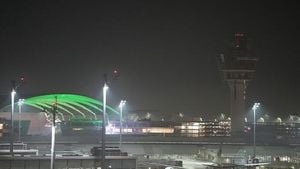On September 1, 2025, Scotland rolled out a sweeping change to its rail network—one that’s been described as nothing short of historic. Peak rail fares, the long-standing system that charged commuters higher prices for traveling during busy weekday mornings and evenings, have been scrapped for good on all ScotRail trains. For thousands of passengers, this means a welcome drop in travel costs and a major shake-up in how Scotland approaches public transportation and climate goals.
For years, peak fares meant that anyone traveling before 9:15 a.m. or during the evening rush on certain routes paid a premium. The numbers paint a vivid picture: a return ticket between Glasgow and Edinburgh, which once cost £32.60 at peak times, now comes in at just £16.80. That’s a saving of almost 50%. Journeys between Perth and Dundee are now a third cheaper, and other routes have seen similar reductions. According to BBC News, the change is expected to put significant money back into commuters’ pockets at a time when many are feeling the pinch from the cost-of-living crisis.
The move follows a turbulent journey. In 2023, the Scottish government—under pressure from the Scottish Greens and trade unions—launched a year-long pilot scrapping peak fares. The experiment saw a modest 6.8% rise in passenger numbers, translating to about four million extra journeys, with half of those replacing car trips. However, the pilot fell short of the 10% increase needed to make it self-financing, leading ministers to reinstate peak fares in September 2024, citing subsidy costs that couldn’t be justified at the time.
But the story didn’t end there. In May 2025, newly installed First Minister John Swinney announced the permanent abolition of peak fares in his programme for government. Speaking at the scheme’s launch in Edinburgh, Swinney was unequivocal: “This is financially sustainable because it's an investment in the rail network and it's an investment in the people of Scotland. People in Scotland simply travelling from Edinburgh to Glasgow on a daily basis will see their travel costs fall by almost 50%. That's a massive saving when people are struggling financially.” According to ITV News, Swinney also framed the decision as a bold step in the fight against climate change and a direct response to the economic pressures facing Scottish households.
ScotRail, which has been under public ownership since 2022, is footing the bill for this policy shift. The annual cost is expected to be between £40 million and £45 million, funded through a combination of fare revenue and the £1.6 billion the Scottish government allocates to rail services each year. If the hoped-for boost in passenger numbers doesn’t materialize, the additional costs will come out of ScotRail’s budget. The government’s bet is that cheaper, simpler fares will entice more people to leave their cars at home—delivering both environmental and financial benefits in the long run.
Joanne Maguire, ScotRail’s Managing Director, is optimistic. She told BBC Scotland News: “We are really excited at the opportunity to get more customers out of their cars and onto the railway. If you are travelling from Edinburgh to Glasgow you will see a saving of about 50%. From Inverkeithing to Edinburgh, you will save 40% and between Inverness and Elgin it is 35%—so it's great news for our passengers.” Maguire also noted that the trial period saw increased passenger numbers and that ScotRail enjoyed a successful summer, moving over 200,000 customers to major events like the Tall Ships Races in Aberdeen and the Edinburgh Festivals.
The change hasn’t just been welcomed by rail bosses and politicians. At Glasgow’s Queen Street station, passengers expressed surprise and delight at the news. Student Robbie McCormack told BBC Scotland News, “I commute every day for college and it's quite expensive. I'll be able to save throughout the week, save more college money and get something else for lunch.” Tommy Whitelaw, who travels across Scotland for charity work, said, “The cost of living shrinks our world, this is one way to open it up a wee bit.”
Political reaction has been robust. The Scottish Greens, who championed the original pilot, celebrated the policy as a victory for fairness and sustainability. Green MSP Mark Ruskell called peak fares a “deeply unfair tax on people who have no say over when they need to travel,” adding, “I am delighted that we are finally rid of them.” The train drivers’ union Aslef echoed this sentiment, with Scottish organiser Kevin Lindsay stating, “The permanent scrapping of peak fares is a victory for rail passengers, the environment, our wider economy and the future wellbeing of Scotland’s rail industry.” However, Aslef also argued that ticket prices should be cut further to make rail travel even more accessible.
Fiona Hyslop MSP, the Cabinet Secretary for Transport, pointed to public ownership as a key enabler of the bold move. “Public ownership has created the opportunity to deliver a railway which is run for the benefit of the nation. ScotRail is one of the fastest growing operators, with one of the best passenger satisfaction rates and we are building even further on this success by removing peak fares for good,” she said in remarks reported by Midlothian View. Hyslop emphasized that the policy aims to make public transport more attractive for work, study, and leisure, while supporting Scotland’s net zero ambitions.
It’s not just regular fares that are changing. Season tickets will remain at their current pricing until September 27, 2025, offering at least 40% savings compared to buying multiple anytime day returns. Flexipass tickets, which cater to part-time and hybrid commuters, have had their pricing adjusted to ensure they still offer a discount over single or return tickets. The super off-peak day return ticket has been withdrawn, as all fares are now available at the same rate throughout the day. Railcards, concessions, and other discounts remain in place, with most still valid for travel after 9:15 a.m.
For some, the new system brings Scotland in line with practices seen elsewhere in Europe. Susan Watts, a passenger from Leeds, told BBC Your Voice, “Our complicated fare system is enough to put anyone off using trains. In Italy, I paid the same price for a ticket when I turned up an hour before as if I'd booked months earlier—the price is just the price.”
Not every route will see dramatic changes; some already offered the same fare at all times. But for the majority of Scotland’s commuters and leisure travelers, the end of peak fares marks a significant shift. It is, as Swinney put it, “an investment in the people of Scotland” and a gamble that more affordable, straightforward rail fares will foster a greener, more connected nation.
As the first week of the new policy unfolds, all eyes are on passenger numbers and the impact on Scotland’s roads and rails. Only time will tell if this ambitious move delivers the hoped-for transformation—but for now, rail travelers across the country are enjoying a rare bit of good news at the ticket counter.





